Why Control Joints Are Essential

OnBoard Newsletter | February 2021
Best Practices to Design and Install Control Joints
There is a reason control joints are considered essential for whatever projects you have in design. Thermal expansion and contraction will occur in buildings – that’s a given – and control joints help prevent resulting cracks and damage. Wind, temperature fluctuation, live loads, deflection or seismic stress all affect the movement of buildings. Control joints relieve these stresses by allowing for movement. Yet there are best practices and installation standards to consider.
National Gypsum’s Construction Design Managers share questions they often receive, which we think you’ll find helpful.


Key Questions and Answers About Control Joints
Q: Why should I include control joints in my designs?
A: Thermal expansion and contraction will occur in buildings, and they often manifest in material finish cracks. Control joints will help prevent cracks caused by thermal expansion and contraction. We recommend using them.
Q: Where should I install control joints?
A: Control joints shall be installed where a wall or partition runs in an uninterrupted straight plane exceeding 30 linear feet (50 linear feet on center for ceilings with perimeter relief).
Q: What are the guidelines for control joints – and are there any exceptions?
A: The Gypsum Association technical document “Application and Finishing of Gypsum Panel Products, GA-216” and ASTM C840 “Standard Specification for Application and Finishing of Gypsum Board” provide the same guidance to install control joints. For details about blocking behind the control joint in a fire-rated system, consult GA-234 “Control Joints for Fire-Resistance Rated Systems.”
Q: What is the difference between control joints and expansion joints?
A: These terms are often used interchangeably, so it depends on who you ask. Control joints prevent cracks in finish materials. Expansion joints (also called construction joints) can reduce the effects of building movement on building materials, and they separate the building structurally. Buildings move as a result of wind, temperature fluctuation, live loads, deflection or seismic stress.
Q: How do I specify control joints? Do I need to include this information in the written specifications, or can I just include it on the drawings?
A: Write your specifications in the gypsum board assemblies section. Include the information to install the gypsum board per GA-216 or ASTM C840. These industry-approved technical documents provide the necessary guidance for installation and location of control joints. You should also indicate the location of control joints on your drawings, especially where aesthetics are important.
Q: Do I need a control joint if I have a deflection track?
A: No, unless your wall exceeds 30 linear feet. The need for control joints is not dictated by the use of deflection track.
Q: For a hyper-sensitive visual project, can I reduce or eliminate the use of control joints?
A: No. Not without limiting straight planes of gypsum board to 30’.
Q: Does the gypsum board thickness affect the design of the joints?
A: No, the design of the control joint is the same for all gypsum board, regardless of thickness (1/2” or 5/8”).
Q: Should I install control joints on exterior gypsum sheathing?
A: It is not mandatory. The standard for the installation of gypsum sheathing, ASTM C1280, “Standard Specification for Application of Exterior Gypsum Panel Products for Use as Sheathing," does not require control joints for the sheathing. The weather barrier and cladding manufacturers will determine the need for control joints. Follow their recommendations.
Q: Does the framing material matter when designing control joints? Is the design different for wood-framed assemblies versus steel-framed assemblies?
A: No, the guidelines are the same for both.
Q: Is there a preference in the control joint material – vinyl or metal?
A: Control joints are available in vinyl and metal, but metal control joints dent more easily. For more guidance, consult the gypsum board section 092900 or 092116 under “Trim Accessories.”
Q: What is the best joint treatment method to prevent cracking?
A: Paper tape and setting compound is the best.
Contact Your NGC Construction Design Manager for More Guidance
If you have additional or specific project questions, don’t hesitate to contact your National Gypsum Construction Design Manager. He or she is here to help you design and build better.
“Virtually all common building materials expand and contract as the result of thermal expansion and hygrometric expansion influences. Gypsum’s movement is microscopic but does happen. Allowing for that movement is important.”
Thad Goodman

Thad Goodman
Construction Design Manager - Central/MidwestNational Gypsum“The Gypsum Association offers, free of charge, the GA 234-2019, “Control Joints for Fire-Resistance Rated Systems.” It’s an excellent resource that provides recommendations on the use of control joints in 1- and 2-hour rated assemblies for metal and wood systems.”
Pat Grotlisch

Pat Grotlisch
Construction Design Manager - WestNational GypsumContact Your NGC Construction Design Manager for More Guidance
If you have additional or specific project questions, don’t hesitate to contact your National Gypsum Construction Design Manager. He or she is here to help you design and build better.
Click here to read previous editions of the OnBoard Newsletter.






